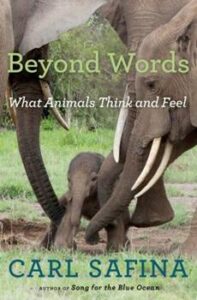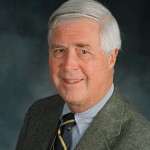 What are they thinking?
What are they thinking?
Do we deliberately misunderstand other animals?
And what is the result of this “miscomprehended relationship”?
Carl Safina, a professor at Stony Brook University in New York and a most curious student of other species, writes a thoroughly loquacious and engaging view of some other sentient creatures whose consciousness may well equal or exceed our own. Arguing that “ . . . humans are not the measure of all things” (as much as we might like us to be), he relates his exhaustive studies of elephants, wolves, dolphins, orcas (killer whales), and his own two dogs, in a global travelogue from Africa to Wyoming, to the Pacific Northwest and to Long Island.
His mantra: “the greatest realization is that all life is one.”
Professor Safina begins with those remarkable creatures, the elephants: “the skin moving like swishing corduroy, textured and rough, but sensitive to the slightest touch. The grind of their cobblestone molars as, sheaf by sheaf and mouthful by mouthful, they acquire the world . . . . Bizarre protruding teeth the size of human legs astride the world’s most phallic nose.”
He acknowledges their consciousness as well as their broad hearing: “elephant song spans ten octaves,” far more than we can hear. And yet theirs is a profile of a species going extinct. Since Roman times, we (the human species) have reduced elephant density by 99 percent. From 10 million in the early 1900s, we count less than 400,000 today.
Note that elephant society is female-dominated. They are empathic to each other. Is there a moral there?
He contrasts their behavior with ours: “self-destructive behavior, for instance, seems distinctly human.” Is male-domination a possible cause? He adds, “modernity’s self-imposed exile from the world seems to have degraded an older human ability to recognize the minds of other animals.” Safina goes on to explore the habits, minds and consciousness of wolves, dogs, and, finally, dolphins and orcas (also known as killer whales).
But inevitably his thoughts turn to us, homo sapiens. We engulf this globe, “ . . . the perfect storm of rising human densities . . . .” and “ . . . most animals of the world are awash in a rising sea of Us.” Pogo had it right!
He concludes: “I don’t mean to imply that I value the life of a fish or a bird the same way I value a human life, but their presence in the world has as much validity as does our presence. Perhaps more: they were here first; they are foundational to us . . . . They enliven the world, and beautifully.”
And then: “If cruelty and destructiveness are bad, humans are by a wide margin the worst species ever to infest this planet. If compassion and creativity are good, humans are by a wide margin the finest. But we are neither simply good nor bad; we are all these things together, and imperfectly so. The question for all is: which way is our balance tending?”
So the professor comes to his conclusion: “Me, I am most skeptical of those things I’d like most to believe, precisely because I’d like to believe them. Wanting to believe something can skews one’s view.”
His final words: “I just don’t know.”
Beyond Words is a challenging and testing read.
Editor’s Note: ‘Beyond Words: What Animals Think and Feel’ by Carl Safina is published by Henry Holt & Co., New York 2015.

Felix Kloman
About the Author: Felix Kloman is a sailor, rower, husband, father, grandfather, retired management consultant and, above all, a curious reader and writer. He’s explored how we as human beings and organizations respond to ever-present uncertainty in two books, ‘Mumpsimus Revisited’ (2005) and ‘The Fantods of Risk’ (2008). A 20-year former resident of Lyme, Conn., he now lives in Peabody, Mass. He writes book reviews, mostly of non-fiction, a subject which explores our minds, our behavior, our politics and our history, but he does throw in a novel here and there. For more than 50 years, he’s put together the 17 syllables that comprise haiku, the traditional Japanese poetry, and served faithfully as the self-appointed “poet laureate” of Ashlawn Farm Coffee. His late wife, Ann, was also a writer, but of mystery novels, all of which begin in a village in midcoast Maine, strangely reminiscent of the town she and her husband visited every summer.